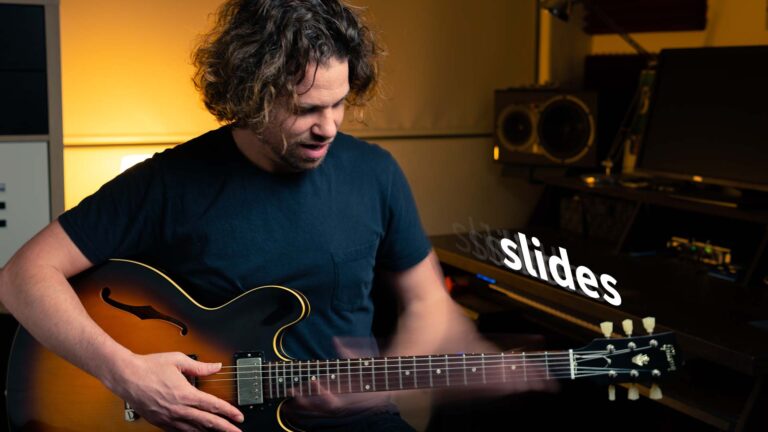The Pentatonic Scale on String Pairs (2/6)
In this lesson, we’ll explore the A Minor pentatonic scale on adjacent string pairs. Having done the single string work in last week’s lesson, you’ll be well prepared for learning this scale along each string pair. And understanding how the notes connect across string pairs is a very valuable thing.
Think about it – If you can connect every pair, then it’s not much of a stretch to connect one pair with another. Do that with every pair and you’ll be connecting pentatonic lines across the whole guitar.
Check out the video if anything is unclear and if you have any questions, feel free to leave a comment in the comments section below this post and I’ll address them as soon as possible.
Alright, let’s get into it!
https://www.youtube.com/watch?v=l1kHvcG_VFo&ab_channel=LincolnMcKenzie
An introduction to the patterns
In this lesson, we’ll look at permutations of 4 consecutive notes within the pentatonic scale. That’s 2 notes on one string, and 2 notes physically below them on the next adjacent string. If you move that pattern consecutively through the scale, you get these 5 combinations of 4 consecutive notes:
ACDE
CDEG
DEGA
EGAC
GACD
As stated before- in every group of 4 notes, 2 will be on one string and 2 will be on the next adjacent string. If this is not making sense yet, don’t worry about it, just follow along and play through all of the exercises. Do the practical stuff first and the understanding will come.
Four Consecutive Notes
Let’s start by arranging our 4 note pattern consecutively along the E and A string pair:

See if you can name the notes as you go. Bar 1 is EGAC. Bar 2 is GACD. Even if you just say the name of the starting note on each bar, it can really help you memorise the note names. Bar 3 starts with A. Bar 4 starts with C and so on…
Another tip: instead of racing through the whole string, try playing each pattern 4 times so that you remember it more accurately. If you’re unsure about which fingers to use, check out the video and just copy what I do.
A natural next step is to play the whole exercise backwards, like this:

Alternating between ascending and descending
Now that you’ve played the notes in order, let’s change it a bit. In Ex.3, the direction reverses in every second bar. So the first bar ascends, the second bar descends, the third bar ascends, the fourth descends, like this:

*Try to maintain an even volume, articulation and length of note as much as possible when playing through these.
Permutations of 4 notes
You can also change the order of the notes within each group. Let’s say we’re dealing with the 4 note group – ACDE. Instead of playing the notes in order, here are the other permutations of ACDE:
ACED CADE CEDA DEAC ECDA
ADCE CAED DACE DECA EDAC
ADEC CDAE DAEC EACD EDCA
AEDC CDEA DCAE EADC
AECD CEAD DCEA ECAD
That’s 24 possibilities in total. For now let’s focus on ADCE. In addition, we’re going to incorporate the alternating ascending/descending idea from Ex.3.
Remember we introduced the idea of intervals in last lesson? Well with this new pattern (ADCE) through the scale, we now have some new intervals (other than major 2nd’s and minor 3rd’s) which we’ll talk about in a minute.
Expand that to the whole string pair and you get this:

The Rolling Technique
You’ll notice that with Ex.4, you end up with a lot of notes on the same fret on adjacent strings. This is problematic on the guitar. There are a few ways to address it, but the one we’re going to focus on is called ‘the rolling technique’.
*Refer to the video for clarification (because it’s much easier to show this technique than explain it without showing you!)
Try it on the 5th fret of the 6th string rolling onto the 5th fret of the 5th string using just the first finger. Start on your fingertip with your finger bent and then roll off the fingertip onto the pad of the fingertip area onto the 5th string. Your fingertip should end up just touching the underside of the 6th string, so that the 6th string is muted. Again, check out the video if this description is confusing, seeing it in action will make a lot more sense!
A good way to practise the rolling technique is to use it as much as possible. Try different positions on the fretboard. Try different fingers. Ex.4 is full of opportunities to practise it so practise that exercise and once you’re comfortable, transfer it to the other string pairs.
*Rolling on the 4th finger is not practical, however you should try it anyway so that you can decide for yourself whether to do it or not.
The Reverse Rolling Technique
Instead of starting on the 6th string and rolling down onto the 5th, you can also start on the 5th string on the pad of your first finger and then roll up onto the 6th string with your fingertip. This is called ‘the reverse rolling technique’. This is also shown in detail in the video.
It’s more challenging than the rolling technique but both are very useful in addressing the challenge of changing between 2 notes on the same fret on adjacent strings. In order to practise this, play Ex.4 in reverse. Start on the 22nd fret of the 5th string. If you don’t have a 22nd fret, start on the previous bar on the 17th fret of the 5th string and work your way from right to left through Ex.4.
Intervals – Perfect 4th’s and Major 3rds
It’s time to revisit the intervals from last week. If you play the scale in order, you get 2 different kinds of intervals:
The major 2nd interval is when the notes are 2 frets apart. In the Am pentatonic scale, major 2nds occur between C and D, D and E, and G and A.
The other interval you get is the minor 3rd, which is 3 frets – A to C, and E to G.
There are even more intervals in this scale once you start skipping notes, which is exactly what is happening in Ex.4. So starting on A, skip C and land on D. A to D is not 2 frets (major 2nd) nor is it 3 frets (minor 3rd). It’s actually 5 frets, or minor 3rd (3 frets) + major 2nd (2 frets).
The name of the interval when the notes are 5 frets apart is called a perfect 4th. If you skip a note in the pentatonic scale, you always get a perfect 4th…with one exception:
If you go from C to E, the notes are only 4 frets apart. This interval is called a major 3rd.
Now you have 4 different intervals:
2 frets apart = Major 2nd
3 frets apart = Minor 3rd
4 Frets apart = Major 3rd
5 Frets apart = Perfect 4th
Here is a list of what intervals you get when you skip a note, from every note in the scale:
A to D = Perfect 4th
C to E = Major 3rd
D to G = Perfect 4th
E to A = Perfect 4th
G to C = Perfect 4th
When played on 2 adjacent strings, Perfect 4ths are almost always on the same fret. The exception is the B&G string pair, which we’ll come back to later.
Going back to Ex. 4, notice that all the perfect 4ths are on the same fret (on adjacent strings) and that one major 3rd interval (C to E) is a different shape.
The A and D string pair
We’ve been working with the E and A pair quite a bit, so let’s take this concept to the A and D string pair. On all of the pairs, it’s probably best to start with the same pattern as Ex.1 to get acquainted with where all the notes are. Practise Ex.5 below and remember to spend a bit of time on each bar to help you to remember where the notes are.
If you can confidently get through the whole exercise both forwards and backwards without looking at Ex.5, you’re ready to try some of the other permutations. Try any one you like. If you’re not sure which one to try first, start with transferring Ex.4 to the A and D string pair.

The other string pairs
Of course, this process should be taken to the other string pairs. I’ll leave it up to you to expand the exercises given, but to give you a starting point on each string, let’s explore another pattern on the D&G string pair. Below in Ex.6 ,we’re using the one where you ascend in the odd bars and descend in the even bars. Try this forwards and backwards. Remember to also do the string set in the normal order as well.

Below in Ex.7, we take the pattern from Ex.4 and transfer it to the B&E pair.

The G and B string pair
As promised, we’re going to talk a bit about the dreaded G&B pair. Everything looks one fret different on this pair. This is because the guitar is tuned in perfect 4ths except for this string pair. This creates nightmares for guitarists but also makes it possible for us to play chords that would otherwise be very difficult if the whole guitar was tuned in perfect 4th’s.
*If the guitar was just tuned in perfect 4ths then the tuning would be EADGCF instead of EADGBE. To experience what life would be like in this tuning, retune the B string to C and the high E string to F and then try to play a six string barre chord with the first string note moved up by one fret. Have fun!
I go into a bit more detail on this in the video, the take-away is that on the G&B pair, major 3rds look like perfect 4ths and perfect 4ths look different than any shape we’re played so far. Spend more time on this string pair to get used to this difference.
Below in ex.8 you can see the new shapes of major 3rds and perfect 4th’s across the whole G&B string set:

Let’s take that pattern, and reverse the direction of every 2nd bar:

FINAL THOUGHTS
I didn’t anticipate that this lesson would be so dense when I started making it. It could easily have been 2 or 3 (or more!) seperate ones but I’m also happy to not drag this one out.
For you, that means you should spend some more time with it and not try to just smash through the material too quickly. Be thorough and don’t be afraid to go back to the previous lesson to revise the names of the notes on each string and reinforce their locations on the neck. Knowing the notes on the individual strings really well will be your saviour when learning the pairs.
Start by doing all of the exercises presented. Then choose a small thing to work on and expand it. Repetition is the key to mastery. Working on a small idea leads to more repetitions in less time. Therefore you will master this quicker if you focus on something small and repeat it a lot.
Here’s some ideas of manageable tasks that you can complete instead of being overwhelmed by the huge amount of possibilities available:
1) Apply Ex.1 and Ex.2 to all string pairs. Play each bar 4 times to start with.
2) Apply 4 different permutations to one string pair. Over time, transfer those permutations to other strings. Write them down.
3) Improvise using only material derived from this lesson. That means to pick a string pair and improvise on only that string pair. Then pick another pair and do the same thing.
4) Improvise with material from this lesson plus any other A minor pentatonic language you have already acquired.
5) Return to lesson 1 and practise naming the notes on each string as you need to. Knowing where the notes are on single strings and being able to name them will significantly improve your ability to navigate the fretboard confidently.
When you’re ready, move on to lesson 3!
Good luck!





